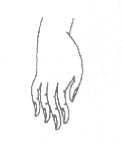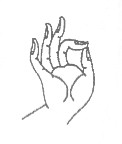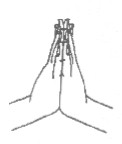MUDRAS: SYMBOLIC HAND GESTURES
Tibetan Buddhist deities are often
represented with hands and fingers in ritual poses, symbolic of their
attributes. "Mudra" is
the Sanskrit term for the symbolic hand gestures used in Buddhist rituals and
accordingly in the iconography. Mudras were introduced into Tibet by
Padmasambhava, an Indian scholar, in the 8th century A.D. They became
part of a ritual language, involving the use of mantras, mudras, and the
thunderbolt scepter, or vajra, that, in Tibet, was known only to the higher
initiates. A Mantra, such as the sacred syllable "Om", had to first be
visualized, then pronounced as sound, and finally expressed physically through
hand gestures, or mudras. Thus
thought, speech and body, the three vehicles for the Divine Presence, are called
into activity. Through these, one can reach samadhi, the highest state of
consciousness. A corresponding idea is inherent in the Tibetan Buddhist Triad,
or Three Jewels, which consists of Buddha, symbolizing Divine Wisdom, the
Dharma, or Law, representing the word, or verbal teachings, and the Sangha
(clergy), standing for the body of Buddhism. Each hand and each finger has a
particular significance. The right hand, for example, is associated with the
moon and male principles. It stands for the spiritual method.
The left hand is associated with the sun and female principles.
It stands for spiritual wisdom.
Examples of the various mudras can be seen
on many statues in the Jacques Marchais Museum of Tibetan Art collections and in
the museum's catalogue, Treasures of Tibetan Art . Below is a brief description
of several mudras.
Protection; Reassurance; Blessing (Abhaya)
 |
This mudra refers to an episode in Buddha's life when a drunken elephant,
sent by the malevolent demon Devadatta, threatened to crush him. With this
gesture Buddha appeased the elephant and subdued him. The gesture dispels
hesitation and fear, instills confidence and trust in the Dharma, and
assures followers of Buddha's protection. The right arm is elevated and
slightly bent. The hand is level with the shoulder, all fingers are
extended upward, and the palm is turned outward. |
Witness; Earthtouching (Bhumisparsa)
 |
With this gesture, Shakyamuni Buddha called upon the earth to witness his
victory over the temptations of Mara, Lord of Illusion.
The right arm is pendant over the right knee. The hand, palm
inward, all fingers down, is touching a lotus throne. The left hand lies
on the lap with the palm upward, as in the Meditation mudra. |
Intellectual Argument; Debate; Appeasement (Vitarka)
 |
The gesture of discussion and debate indicates communication and an
explanation of the Dharma. The tips of the thumb and index finger touch,
forming a circle. All other fingers are extended upwards. Sometimes the
middle finger and thumb touch, which is gesture of great compassion. If
the thumb and ring finger touch, they express the mudra of good fortune. |
Prayer; Adoration; Salutation; Reverence (Anjali, Namaskara)
 |
In India, this gesture indicates salutation and respect. In
Buddhist iconography, it symbolizes adoration. If held under the mouth, it
indicates homage to the word of the teacher. It is, therefore, never seen
on Buddha himself, as he is the subject of reverence. The two hands joined
together also symbolize the static and dynamic, the spiritual and the
material worlds. The hands are kept close to the chest in devotional
attitude with the palms and fingers pressed together. |
Meditation (Dhyana or Samadhi)
 |
The highest state of consciousness, Samadhi, can be reached by means of
deep concentration, tranquility and identification with the supreme unity.
This gesture of meditation, made with both hands, or with the left hand
alone, indicates deep Samadhi, or absolute balance. Both hands are placed
in the lap, right hand on left hand, with all fingers extended and palms
facing upward. Thumbs touch each other. |
Teaching; Preaching, Turning the Wheel of Law (Dharmachakra)
 |
This gesture indicates the turning of the
Wheel of Dharma, or law, in which Buddhas, through their teachings, set
the Dharma in motion for beings of the six realms of existence. Both hands
are held against the chest, with the left hand facing inward, covering
right hand facing outward. The index finger and thumb of each hand form a
circle, the 'wheel'.
|
Source, Jacques Marchais Museum of Tibetan
Art, Staten Island, NY






